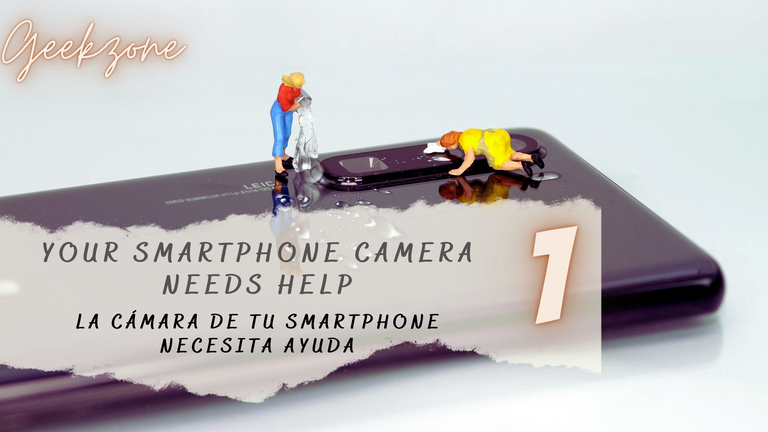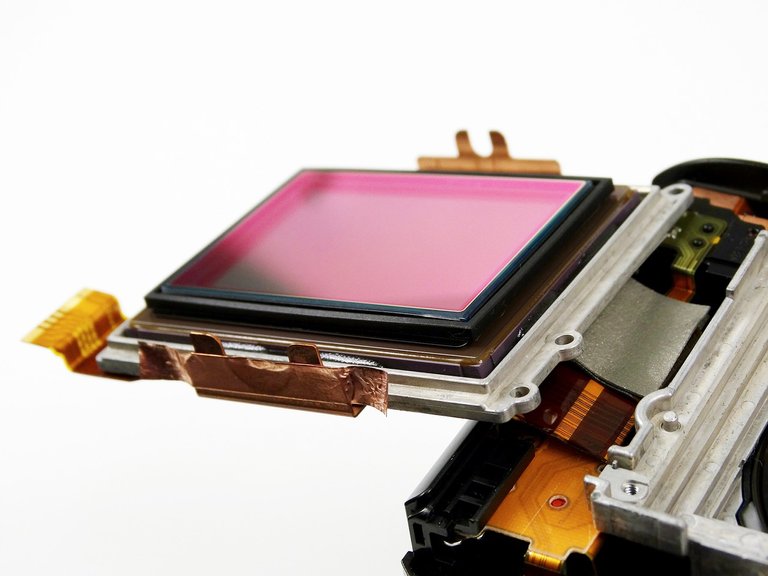[EN-ESP] Your Phone's Camera Sucks | La cámara de tu teléfono apesta

You have probably noticed that no matter how good your device's cameras get, somehow, someway, a DSLR (Digital Single-Lens Reflex) camera, will almost always produce distinctive shots that your mobile device may be unable to match. This is also the case even when your device have multiple cameras. So, is your phone's camera trash?
Not at all, we cannot dismiss quickly how advanced our mobile devices have become lately, serving as a do-it-all device, and along with all advancements, the camera has been one of the focal points for manufacturers, and granted, their investments in time and efforts have been paying off, smartphone cameras have become better, and sometimes, as good as DSLRs. But they still suck for some reasons. Here are some common reasons:
- Sensor size
- Amateurism
- Computational photography
To avoid information overload, I will discuss the above facts over three posts, so, in this post, we will be focusing on sensor size.

SENSOR SIZE
Due to size constraints, their is limit to the size of image sensor that could be packed into a smartphone camera compartment, when compared to a full frame camera. In fact, the whole body of a DSLR is mostly designed to accomodate the camera sensor, compared to a smartphone whose design aims to pack in a lot of digital components into one place, that is not up to 3/10th of the DSLR.
The camera sensor plays a significant role in the quality of a photo or video. Let's talk about photosites. The photosites in a camera sensor can be referred to as tiny sensors inside the sensor itself. These photosites are photosensitive diodes that capture light in form of photons and then convert it into electrons, so they can be easily interpreted by the camera software.
The smaller the sensor size, the fewer the number of photosites, which effectively translates to lesser light being captured, and then poorer image quality.
The significance of the sensor size in a phone camera can be felt in two major situations:
- Low-light
- Video recording
As a result of there being fewer photosites on the sensors of smartphones, smartphones typically have a difficult time capturing enough light to brighten a scene when operating in a low-light environment, such as a darkroom or during the night. As a result, "night mode" on smartphones was developed to address this issue (nightography, night sight, etc.). Night mode is a feature that is available on most smartphones and allows the device to work on your image when there is insufficient light and attempt to brighten it by utilizing a variety of computational photography algorithms that were pre-programmed into the device. Night mode can be found in most smartphones. Even though it has some limitations (it cannot handle shakes, and the majority of phones do not support night mode for videos), we find that night mode photos are always very helpful.
Take away the computational aspects of photography and you will have a better understanding of the role that the smartphone sensor plays in the overall image and video quality. This is what is achieved during videography (when taking videos on your phone)." It is extremely challenging to apply computational photography techniques to video recordings due to the inherent characteristics of video recordings, which essentially involve piecing together a number of still images and audio from a single recording session. Therefore, the implication here is that there is very little that can be done by your phone to improve the video quality; rather, it relies more on the limited camera hardware that is present here. Because of this, it is not uncommon to find smartphones that have excellent capabilities for taking photographs but only very average capabilities for recording video.
I hope you learnt something new. This is my first post here, and I hope to be creating more with time. Thanks for reading through!

Probablemente te hayas dado cuenta de que una cámara DSLR (Digital Single-Lens Reflex) casi siempre produce imágenes distintivas que la cámara de tu dispositivo móvil puede no ser capaz de igualar, y esto es cierto independientemente de lo buena que sea la cámara de tu dispositivo. Esto sigue siendo así incluso si el dispositivo que utilizas tiene más de una cámara. Entonces, ¿por qué tu smartphone no rinde tanto como una DSLR?
La cámara de tu smartphone es perfectamente adecuada en todos los sentidos. Junto con todos los avances, la cámara ha sido uno de los puntos centrales para los fabricantes, y es cierto que sus inversiones en tiempo y esfuerzos han dado sus frutos, las cámaras de los smartphones se han vuelto mejores, y a veces, tan buenas como las DSLR. No podemos descartar rápidamente lo avanzados que se han vuelto nuestros dispositivos móviles en los últimos tiempos, sirviendo como un dispositivo para todo. Sin embargo, a pesar de ello, su rendimiento puede ser terrible en muchos aspectos. He aquí algunas razones comunes:
- Tamaño del sensor
- Amateurismo
- Fotografía computacional
Para evitar la sobrecarga de información, trataré los hechos anteriores a lo largo de tres posts, así que, en este post, nos centraremos en el tamaño del sensor.

TAMAÑO DEL SENSOR
Debido a las restricciones de tamaño, el tamaño del sensor de imagen que puede caber en el compartimento de la cámara de un smartphone es limitado en comparación con el de una cámara de fotograma completo. De hecho, todo el cuerpo de una DSLR está diseñado principalmente para albergar el sensor de la cámara, en comparación con un smartphone cuyo diseño tiene como objetivo empaquetar una gran cantidad de componentes digitales en un solo lugar, que no llega a la 3/10 parte de la DSLR.
El sensor de la cámara juega un papel importante en la calidad de una foto o un vídeo. Hablemos de los fotositos. Los fotositos de un sensor de cámara se pueden denominar como pequeños sensores dentro del propio sensor. Estos fotositos son diodos fotosensibles que capturan la luz en forma de fotones y luego la convierten en electrones, para que puedan ser interpretados fácilmente por el software de la cámara.
Cuanto menor sea el tamaño del sensor, menor será el número de fotositos, lo que se traduce en una menor captación de luz y, por tanto, en una peor calidad de imagen.
La importancia del tamaño del sensor en la cámara de un teléfono se puede apreciar en dos situaciones principales:
- Con poca luz
- Grabación de vídeo
En una situación de luz baja, puede ser en un cuarto oscuro, o en la noche, como resultado de la menor cantidad de fotositos en los sensores de los teléfonos inteligentes, los teléfonos inteligentes suelen tener dificultades para capturar suficiente luz para iluminar una escena, de ahí, el **nacimiento del modo nocturno en los teléfonos inteligentes (nightography, night sight, etc.). El modo nocturno es una función de la mayoría de los teléfonos inteligentes en la que, como consecuencia de la escasa luz, el teléfono inteligente trabaja en su imagen y trata de aclararla utilizando diferentes algoritmos de fotografía computacional incorporados en el teléfono inteligente. Las fotos en modo nocturno nos gustan, aunque son limitadas (no puede manejar las sacudidas, y la mayoría de los teléfonos no admiten el modo nocturno para los vídeos), pero siempre son súper útiles.
Para apreciar el papel del sensor del smartphone en la calidad de la imagen y el vídeo, quita la fotografía computacional, y eso es lo que hace la videografía. Debido a la naturaleza de las grabaciones de vídeo, que implica esencialmente la unión de varios fotogramas de fotos y audio, es esencialmente difícil aplicar los trucos de la fotografía computacional a los vídeos. Por lo tanto, la implicación aquí es que hay muy poco que tu teléfono pueda hacer para mejorar la calidad del video, depende más del limitado hardware de la cámara aquí. Por esta razón, es común ver smartphones con muy buena calidad de foto pero con un rendimiento de grabación de vídeo muy mediocre.
Espero que hayas aprendido algo nuevo. Este es mi primer post aquí, y espero ir creando más con el tiempo. Gracias por leerlo.

Companies that make DSLR cameras are in serious trouble right now. Some speculate that Nikon, arguably the best DSLR company in the business, might go bankrupt.
Single-lens reflex cameras use a combination of a prism and mirror. The photographer looks through the lens, adjusts the focus then sets the shutter speed and aperature then snaps the photo.
To take the photo, the SLR flips the mirror which redirects the light from the view finder to the photo element.
This set up does not work with video! That little mirror would have to flap back and forth between each frame and there is not time for the photographer to readjust settngs between frames.
The new "mirrorless" cameras from Sony (and a few others) have photo elements that are pretty much on all the time. The photo elements will sample the light from an image over a period of time. The camera's software will then stitch together a crisp image based on the sampling.
Since the cameras sample the image over a period of time, the cameras do not need the expensive lenses needed by SLR cameras.
The software in digital cameras offer image stabilization. Image stabilization is not that terribly difficult. If the camera noticed that all of the pixels shifted between samplings, that the camera most likely moved.
The current generation of cameras compete on which camera has the best software. Some smart phones have extremely advanced software.
I would not be surprised to see mirrorless cameras completely replace SLR and DSLR cameras in the near future.
True. Digital cameras are more advanced currently. Smartphones are really catching up.
Lately, there has been move towards the adoption of an inch camera sensor which is a huge achievement I must say.
The current state of cameras won't remain the same in just a few years.
Yay! 🤗
Your content has been boosted with Ecency Points, by @zestimony.
Use Ecency daily to boost your growth on platform!
Support Ecency
Vote for new Proposal
Delegate HP and earn more
Smaller sensors, fewer photosites 🤔
I got value from tour article dear. Thank you you sharing.
Welcome Sapphire! I'm happy you found it
My pleasure dear 🤗
Si @zestimony , eso note durante los segmentos que grabe para subirlos a 3speak; hubo un momento en que la imagen se saturo de luz, y note que debia de vez en cuando buscar un mejor punto de enfoque. Y bueno, eso tambien se me pudo agravar por el amateurismo que mencionas y del que escribiras en tu proxima publicacion; espero.
Sí, definitivamente, ya estoy trabajando en la próxima publicación. Pronto estará lista. Si te parece bien, puedo etiquetarte en la próxima publicación.
De todos modos, ¡gracias por pasarte por aquí!
Si @zestimony , etiquetame nomas, para que no se me pase por alto ;)
As someone who has been always shooting with phones only and never owned a real camera, I was quite disappointed by the title of your post but I must admit that I learned some new cool stuff here and you obviously put a lot of effort into this post so it´s my pleasure to support it as it was nominated to my latest upvote giveaway :) Great post indeed, keep up the good work man! :)
@tipu curate
Upvoted 👌 (Mana: 0/42) Liquid rewards.
Thanks a lot @phortun for the support. I really appreciate! I'll continue dishing out more quality contents!